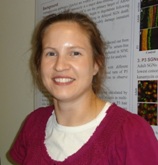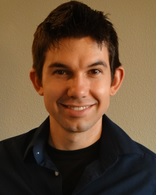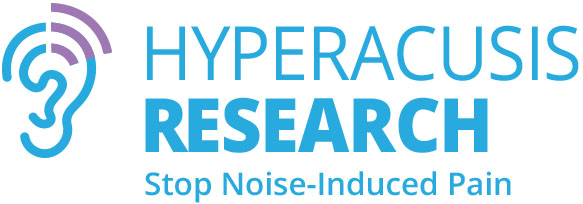Hyperacusis Research is excited to fund two Emerging Research Grants for the Hearing Health Foundation’s 2015 grant cycle. The first grant covers the important topic of pain mechanisms associated with hyperacusis while the second grant investigates mechanisms associated with moderate noise-induced damage and its effects on the auditory system. We are extremely grateful for our donor support which made possible the support of a second grant in 2015 as we had initially only planned on supporting one Emerging Research Grant for this cycle. Below are descriptions of these two important research projects:
 Kelly Radziwon, Ph.D.
Kelly Radziwon, Ph.D.
SUNY University at Buffalo
The relationship between pain-associated proteins in the auditory pathway and hyperacusis.
Hyperacusis is a condition in which sounds of moderate intensity are perceived as intolerably loud or even painful. Despite the apparent link between pain and hyperacusis in humans, little research has been conducted directly comparing the presence of inflammation along the auditory pathway and the occurrence of hyperacusis. One of the major factors limiting this research has been the lack of a reliable animal behavioral model of hyperacusis. However, using reaction time measurements as a marker for loudness perception, I have successfully assessed rodents for drug-induced hyperacusis and, more recently, noise-induced hyperacusis. Briefly, the rodents will be trained to detect noise bursts of varying intensity. As in humans, the rodents will respond faster with increasing sound intensity. Following drug administration or noise exposure, rodents will be deemed to have hyperacusis if they have faster-than-normal reaction times to moderate and high-level sounds. Therefore, the goal of the proposed research is to correlate the presence of pain-related molecules along the auditory pathway with reliable behavioral measures of drug and noise-induced hyperacusis.
Long term goal: Since we have developed a reaction time paradigm that can reliably separate animals with hyperacusis from animals with loudness recruitment and normal loudness perception, we can now identify the biological correlates of this hearing disorder. Given that ear pain often co-occurs with hyperacusis, we felt that the most relevant biological markers of hyperacusis might be the expression of pain-related molecules found in the auditory system. Therefore, the long-term goals of this project are to determine the relationship between pain-related molecules and inflammation along the auditory pathway and the perceptual experience of hyperacusis. We will start by focusing on three molecules, SP, NK1, and TRPV1, but will adjust our biochemical analysis depending upon the results of this project. However, if these molecules are correlated with hyperacusis, then this will provide the biological markers needed for the development of treatments for ear pain and hyperacusis.
Kelly Radziwon, Ph.D. received her Ph.D. in Cognitive Psychology from the University at Buffalo, SUNY in 2013. Currently, she is a post-doctoral fellow in Dr. Richard Salvi’s lab in the Center for Hearing and Deafness at the University at Buffalo. Dr. Radziwon’s research interests include animal psychoacoustics as it relates to hearing loss, tinnitus, and hyperacusis.
Brad Buran, Ph.D.
Oreg on Health & Science University
on Health & Science University
Neural mechanisms of hyperacusis in the inferior colliculus and cortex of animals with noise-induced auditory neurodegeneration.
The development of effective treatments for hyperacusis (the diminished tolerance of loud sounds) and tinnitus (a persistent ringing in the ears) is limited by existing animal models. Current animal models are generated by high-intensity noise exposure or by the administration of salicylate, the active ingredient in aspirin. In addition to producing symptoms of hyperacusis and tinnitus, both of these manipulations lead to elevated hearing thresholds by damaging inner ear sensory cells. Damage to inner ear sensory cells leads to altered auditory processing, which makes it difficult to identify the specific changes that produce hyperacusis and tinnitus. While hearing loss is the primary risk factor for these disorders, they cannot be explained by damage to sensory cells alone. In fact, hyperacusis, tinnitus, and difficulty understanding speech in noise have been reported even in individuals with normal auditory thresholds. Therefore, in order to tease out the specific changes to the auditory system that result in tinnitus and hyperacusis, the ideal animal model should not have sensory cell damage.
Recent evidence from studies in rodents suggests that moderate noise exposure can cause damage to the auditory nerve without altering hearing thresholds. Rodents with this type of auditory nerve damage show symptoms of hyperacusis and humans who report tinnitus, but have normal auditory thresholds, also show signs of similar damage. It has also been hypothesized that auditory nerve damage will lead to increased difficulty understanding speech in the presence of background noise. Thus, moderate noise exposure provides a potential animal model for patients who have normal hearing thresholds, yet still experience hyperacusis, tinnitus, or difficulty hearing in noise. We will assess the perceptual effects of this auditory nerve damage by training noise-exposed animals to perform behavioral tests designed to parallel tests of hyperacusis, tinnitus, and difficulty hearing in noise that are conventionally used in human listeners. We will also assess how auditory responses in the central auditory system are altered by this type of auditory deficit to determine whether the changes in neural responses may explain the perceptual effects of hyperacusis, tinnitus, and difficulty hearing in noise.
Long term goal: To understand how hearing loss alters central auditory system function and how this abnormal function can be ameliorated to improve auditory outcomes.
Brad Buran completed a Ph.D. in the Harvard-MIT Program in Speech and Hearing Bioscience and Technology. He subsequently completed a postdoctoral fellowship at New York University with Dr. Dan Sanes, worked for Galenea, Corp. as a research scientist and is now a postdoctoral fellow in Dr. Stephen David’s laboratory in the Oregon Hearing Research Center at Oregon Health & Science University.

